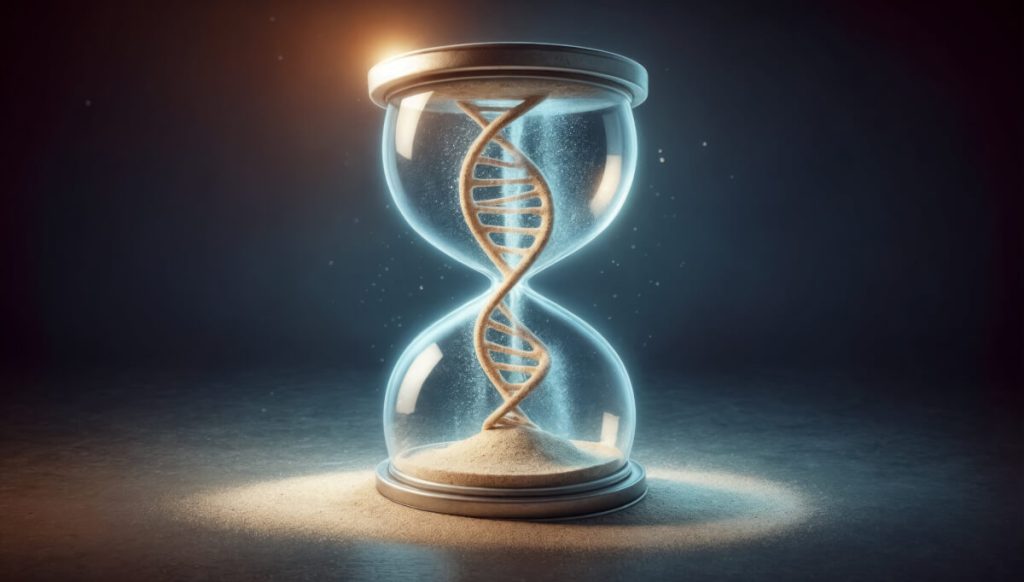

(© Dmytriy – stock.adobe.com)
In a nutshell
- Scientists discovered that random DNA mutations don’t just cause local damage, they trigger widespread changes across thousands of nearby genes through a process called methylation, explaining why aging affects our bodies so extensively.
- Researchers could predict a person’s biological age almost as accurately by looking at their DNA mutations as by examining epigenetic changes, suggesting these two aging processes are deeply interconnected rather than separate.
- This finding challenges current anti-aging research focused solely on reversing epigenetic changes, as these changes may be symptoms rather than root causes of aging – making the development of anti-aging treatments more complex than previously thought.
SAN DIEGO — Scientists have long wondered what makes our bodies age. Is it like a car slowly breaking down from wear and tear? Or more like a computer whose programming gradually goes awry? A new study from the University of California San Diego suggests both perspectives might be right, and in effect, challenges current approaches to anti-aging research.
For years, researchers have debated two main theories about why we age. The first suggests aging happens because our DNA accumulates random damage over time, like a beloved book slowly collecting tears and stains. The second theory focuses on epigenetic changes. These are modifications that control which genes are active without changing the DNA sequence itself, similar to how a piano goes out of tune in a specific pattern.
In recent years, scientists and biohackers have sought out ways to “reset” our epigenetic clocks in order to slow down the aging process. This latest study, published in Nature Aging, however, suggests DNA mutations prevents this level of biohacking from becoming a reality.
“Major research institutions and companies are betting on turning back the epigenetic clock as a strategy to reverse the effects of aging, but our research suggests that this may only be treating a symptom of aging, not the underlying cause,” explains Trey Ideker, Ph.D., a professor at UC San Diego School of Medicine and the Jacobs School of Engineering, in a statement.


By examining data from over 9,300 people, researchers discovered these two aging processes are closely linked. At the heart of this discovery are special spots in our DNA called CpG sites, where scientists can attach small chemical tags (methylation marks) that help control nearby genes. These tags work like tiny volume knobs that can turn genes up or down. As we age, the pattern of these marks changes so predictably that scientists have created “biological clocks” that can estimate someone’s age just by looking at their methylation patterns.
“Epigenetic clocks have been around for years, but we’re only now beginning to answer the question of why epigenetic clocks tick in the first place,” says first author Zane Koch, a Ph.D. candidate in bioinformatics at UC San Diego. “Our study demonstrates for the first time that epigenetic changes are intricately and predictably tied to random genetic mutations.”
What makes this discovery particularly fascinating is that when DNA damage occurs at CpG sites, it doesn’t just affect that single location. Instead, it creates a ripple effect, changing how genes are controlled across surprisingly long stretches of DNA — up to 10,000 genetic letters in either direction. This finding helps explain a puzzle that has long confused scientists: DNA damage happens relatively rarely and randomly, yet the changes in gene control that occur with aging are widespread and consistent. The new research shows that each instance of DNA damage can influence hundreds of nearby control switches, amplifying its impact far beyond the original site of damage.


Even more remarkably, the research team found they could predict someone’s age almost as accurately by looking at their pattern of DNA damage as they could by examining their methylation marks. Both methods even agreed on which individuals were biologically “older” or “younger” than their actual age would suggest.
“If somatic mutations are the fundamental driver of aging and epigenetic changes simply track this process, it’s going to be a lot harder to reverse aging than we previously thought,” notes co-corresponding author Dr. Steven Cummings, executive director of the San Francisco Coordinating Center at UC San Francisco. “This shifts our focus from viewing aging as a programmed process to one that’s largely influenced by random, cumulative changes over time.”
Paper Summary
Methodology
The researchers analyzed data from The Cancer Genome Atlas and the Pan-Cancer Analysis of Whole Genomes, examining both tumor and normal tissue samples from thousands of individuals. They looked specifically at how DNA mutations correlated with methylation patterns, using sophisticated statistical analyses to control for various factors including tissue type and age. The team developed computational models to predict age based on mutation patterns and compared these predictions to traditional epigenetic clock estimates.
Results
The study found that CpG mutations were associated with decreased methylation at the mutation site and extensive remodeling of methylation patterns in surrounding DNA regions. Mutation-based age predictions achieved a correlation of 0.67 with chronological age, while methylation-based predictions achieved a correlation of 0.83. Importantly, both methods agreed on which individuals were aging faster or slower than expected, with a significant correlation between their predictions even after controlling for chronological age.
Limitations
Most of the analyzed samples came from cancer patients, though the findings were validated in normal tissues from a subset of individuals. The study primarily relied on DNA sequencing of exomes (protein-coding regions) rather than whole genomes. Additionally, the research was cross-sectional rather than longitudinal, meaning each individual was only measured at a single time point.
Discussion & Implications
The research suggests a possible mechanistic link between two major hallmarks of aging – DNA mutations and epigenetic changes. This could help resolve debates about which process is more fundamental to aging and guide the development of anti-aging interventions. The findings also highlight the importance of DNA maintenance and repair in aging biology.
Funding & Disclosures
The study was funded by the National Institutes of Health and The Sequoia Center for Research on Aging. One author disclosed being a cofounder of two companies and serving on scientific advisory boards, with arrangements reviewed and approved by the University of California, San Diego.
Publication Information
The paper “Somatic mutation as an explanation for epigenetic aging” was published in Nature Aging in January 2025. Authors include Zane Koch, Adam Li, Daniel S. Evans, Steven Cummings, and Trey Ideker from the University of California San Diego, California Pacific Medical Center Research Institute, and University of California San Francisco. The study was funded by the National Institutes of Health through grants U54 CA274502 and P41 GM103504.






